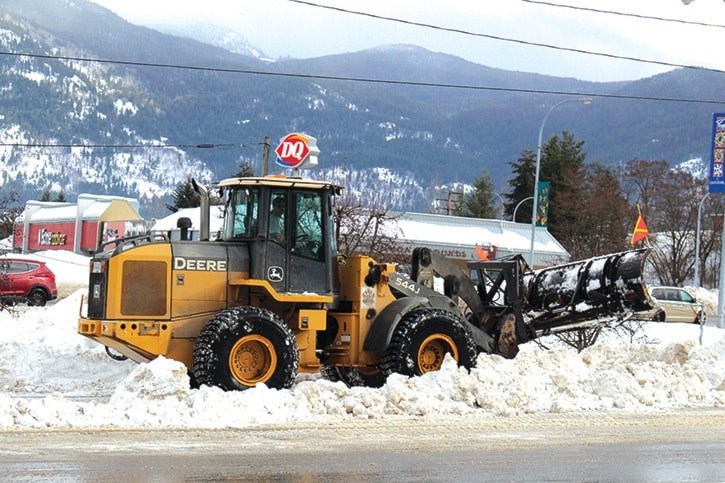The City of Castlegar may have already spent half of 2017’s snow plow budget — though based on last year’s data that may not be unusual.
While council has yet to approve the 2017 city budget — typical this time of year — the proposed snow plow budget is $503,300, compared to last year’s total budget of $497,400. So far the city has recorded $196,000 in snow plow expenses, 39 per cent of the budget. In comparison, the city had spent $233,000 by the end of February last year — 47 per cent of the total budget.
But this year’s expenses have so far only been recorded up to Feb. 3, which doesn’t include the large dumps of snow that Castlegar received last week.
“With public works we operate on time cards and activities, so obviously last week the guys spent a lot of their time on winter road maintenance, because we had that big snow dump, and that’s not reflected in the $196,000 in expenses that we’ve incurred so far,” explains Andre Buss, director of finance.
Between Friday, Feb. 3 and last Monday, Castlegar received 33.4 centimeters of snow and received another 13 cm overnight last Wednesday, 7.8 cm last Thursday and 0.2 cm on Friday. And there’s another storm system on its way, though it may not bring snow.
“The next storm is coming in Wednesday night and it’s going to continue with precip. through Thursday. It’s probably going to be rain in the valley,” said Jesse Ellis, weather forecaster at the Southeast Fire Centre.
Earlier this week, Ron Lakeman, meteorologist with the Southeast Fire Centre, laid to rest the rumour that Castlegar was having its heaviest snowfall in 100 years. “The amount of snow which fell in Castlegar Friday through Monday was far less than what occurred elsewhere,” he said.
A daily record was broken on Feb. 3 (more snow fell on that specific date than had fallen on that specific date since records started being kept), but the 12.6 cm of snow was nowhere near breaking February’s extreme daily snowfall record of 27.7 cm that was set on Feb. 8, 1969.
Though it wasn’t the heaviest snowfall Castlegar has ever experienced, it did cause some disruption. The Stanley Humphries Secondary School’s senior boys basketball team was scheduled to host a tournament last weekend, but it had to be cancelled because the East Kootenay teams weren’t allowed to travel on the roads.
The weather also prompted the Regional District of Central Kootenay (RDCK) to issue a release advising residents “to take precautions as heavy winter conditions continue through the Kootenay region. These precautions include preparing emergency plans and 72 hour kits containing tools and items necessary to protect your homes and properties.”
The RDCK also encouraged residents to follow weather alerts, driving conditions, and learn about carbon monoxide safety in winter and removing snow and ice from their roofs.
If the weight of snow on your roof is producing signs of stress — “unusual sounds from the roof or supporting walls, visible movement of walls or sagging of ceiling and cracking of drywall or plaster,” or door jams or water leaks that show up after a large snow fall — then the National Research Council of Canada advises hiring a “qualified and insured” contractor to clear your roof for you.
Avalanche Canada issues avalanche warnings in areaLast week Avalanche Canada also issued a special public avalanche warning for backcountry users in the region between Friday and Monday, which included the southern part of the Purcells region, the eastern part of the Kootenay Boundary region, Kananaskis Country and Waterton Lakes National Park and Avalanche Canada’s South Rockies and Lizard and Flathead regions.
The release warned that in many areas heavy snowfall had “doubled the depth of the current snowpack. Winds have created dense slabs that lie on a weak base of sugary facetted snow.”
Given that the weather was expected to clear up over the week, which it did, Avalanche Canada was worried recreational backcountry users would be tempted into avalanche terrain.
“Clearing skies and good riding conditions after a long drought are expected to entice people into the mountains,” explained James Floyer, forecasting program supervisor for Avalanche Canada. “While natural avalanches are tapering off, we’re concerned that human triggering of large avalanches remains possible throughout the weekend.”
Avalanche Canada continues to issue new warnings for all of the areas previously mentioned.
Before heading out to the backcountry, remember to check avalanche.ca for updates.
